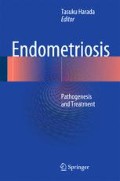Abstract
Endometriosis is an enigmatic disease, despite a long history of research into its basic science and clinical aspects. Sampson published his pioneer article in 1927, theorizing that retrograde menstruation may cause peritoneal endometriosis. Since that time, researchers throughout the world have wrestled with the mysteries of the disease. In this book, we bring you a compendium of the present understanding of the pathogenesis of endometriosis as well as how this information may be applied in current therapies. As editor, I invited an international group of distinguished scientists to contribute a chapter and was happy that all graciously agreed to do so. Our hope is that this book will provide useful information and fresh knowledge to all doctors and scientists interested in endometriosis, and that it will stimulate further research, and lead to more efficacious treatment modalities.
Access this chapter
Tax calculation will be finalised at checkout
Purchases are for personal use only
References
Sampson JA. Peritoneal endometriosis due to the menstrual dissemination of endometrial tissue into the peritoneal cavity. Am J Obstet Gynecol. 1927;14:422–69.
Peterson CM, Johnstone EB, Hammoud AO, Stanford JB, Varner MW, Kennedy A, Chen Z, Sun L, Fujimoto VY, Hediger ML, Buck Louis BM. Risk factors associated with endometriosis: importance of study population for characterizing disease in the ENDO study. Am J Obstet Gynecol. 2013;208:451.
Eskenazi B, Warner ML. Epidemiology of endometriosis. Obstet Gynecol Clin North Am. 1997;24:235–58.
Sasson IE, Taylor HS. Stem cells and the pathogenesis of endometriosis. Ann N Y Acad Sci. 2008;1127:106–15.
Redwine DB. Was Sampson wrong? Fertil Steril. 2002;78:686–93.
Harada T, Iwabe T, Terakawa N. Role of cytokines in endometriosis. Fertil Steril. 2001;76:1–10.
Iba Y, Harada T, Horie S, Deura I, Iwabe T, Terakawa N. Lipopolysaccharide-promoted proliferation of endometriotic stromal cells via induction of tumor necrosis factor alpha and interleukin-8 expression. Fertil Steril. 2004;82:1036–42.
Takenaka Y, Taniguchi F, Miyakoda H, Takai E, Terakawa N, Harada T. Lipopolysaccharide promoted proliferation and invasion of endometriotic stromal cell via induction of cyclooxygehase-2 expression. Fertil Steril. 2010;93:325–7.
Lee B, Du H, Taylor HS. Experimental murine endometriosis induces DNA methylation and altered gene expression in eutopic endometrium. Biol Reprod. 2009;80:79–85.
Santamaria X, Massasa EE, Taylor HS. Migration of cells from experimental endometriosis to the uterine endometrium. Endocrinology. 2012;153:5566–74.
Sharpe KL, Vernon MW. Polypeptides synthesized and released by rat ectopic uterine implants differ from those of the uterus in culture. Biol Reprod. 1993;48:1334–40.
Machado DE, Berardo PT, Palmero CY, Nasciutti LE. Higher expression of vascular endothelial growth factor (VEGF) and its receptor VEGFR-2 (Flk-1) and metalloproteinase-9 (MMP-9) in a rat model of peritoneal endometriosis is similar to cancer disease. J Exp Clin Cancer Res. 2010;29:4.
Author information
Authors and Affiliations
Corresponding author
Editor information
Editors and Affiliations
Rights and permissions
Copyright information
© 2014 Springer Japan
About this chapter
Cite this chapter
Harada, T. (2014). Endometriosis: A Mysterious Disease. In: Harada, T. (eds) Endometriosis. Springer, Tokyo. https://doi.org/10.1007/978-4-431-54421-0_1
Download citation
DOI: https://doi.org/10.1007/978-4-431-54421-0_1
Published:
Publisher Name: Springer, Tokyo
Print ISBN: 978-4-431-54420-3
Online ISBN: 978-4-431-54421-0
eBook Packages: MedicineMedicine (R0)

